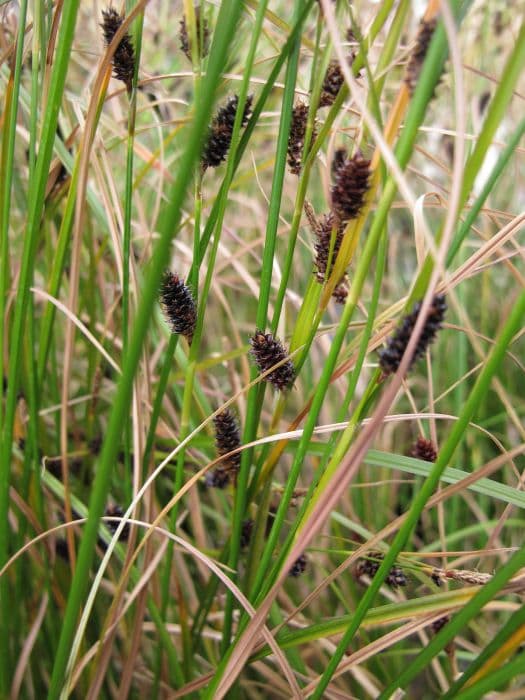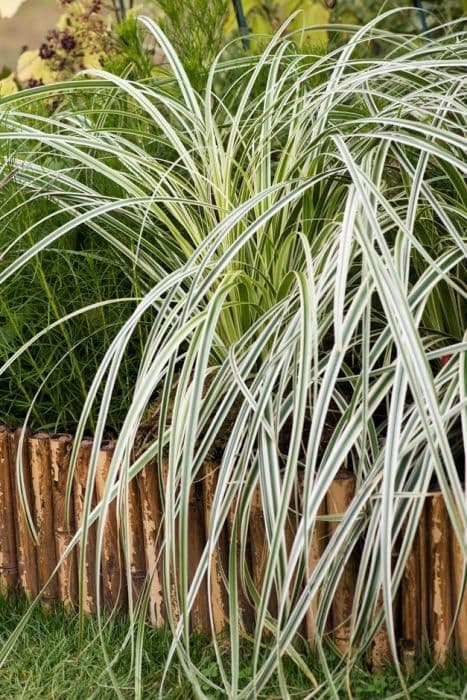Royal flatsedge Cyperus involucratus

ABOUT
Cyperus involucratus, commonly known as the Umbrella Plant, showcases a distinctive growth pattern that resembles the spokes of an open umbrella. It stands out with its radiating clusters of slender, grass-like leaves that bend downward gracefully at the top of the central stem, creating an overall fountain-like effect. The leaves are bright to medium green, smooth, and have a glossy appearance, contributing to the lush, tropical feel of the plant. At the end of each stem, the Umbrella Plant forms a bristled, umbrella-like structure from which tiny flowers or sometimes spikes emerge. These flowers are often subtle and not particularly showy, taking a backseat to the plant's striking foliage. What draws attention is the unique arrangement of the bracts, which are leaf-like structures that cup the small flowers, giving an ornamental edge to the overall appearance. The stems are sturdy, holding the distinctive leaf formation high and contributing to the plant's iconic silhouette. Overall, the Umbrella Plant possesses an elegant and architectural presence, adding a touch of the tropics to places where it is cultivated.
About this plant
 Names
NamesSynonyms
Umbrella Sedge, Umbrella Plant, Dwarf Papyrus
Common names
Cyperus alternifolius subsp. flabelliformis, Cyperus flabelliformis.
 Toxicity
ToxicityTo humans
The most common common name for Cyperus involucratus is the "Umbrella Plant." This plant is not known for its toxicity to humans; therefore, ingestion of this plant typically does not lead to serious poisoning or life-threatening conditions. However, as with many plants, sensitive individuals may experience mild gastrointestinal discomfort if parts of the plant are ingested, including symptoms such as nausea, vomiting, or diarrhea.
To pets
The common name for Cyperus involucratus when referring to pets is "Umbrella Plant." This plant is generally considered non-toxic to pets such as cats and dogs. It does not pose a significant risk of poisoning if ingested by these animals. Pets might experience slight digestive upset if they consume parts of the Umbrella Plant, but this occurrence is not commonly reported.
 Characteristics
CharacteristicsLife cycle
Perennials
Foliage type
Evergreen
Color of leaves
Green
Height
2-3 feet (60-90 cm)
Spread
2-3 feet (60-90 cm)
Plant type
Herb
Hardiness zones
9
Native area
Africa
Benefits
 General Benefits
General Benefits- Erosion Control: Cyperus involucratus, commonly known as umbrella plant, helps in stabilizing soil and preventing erosion due to its dense root system.
- Ornamental Value: The unique structure and greenery of the umbrella plant make it an attractive addition to gardens and indoor plant collections.
- Wildlife Habitat: It provides shelter and habitat for various small wildlife and aquatic creatures when grown near ponds or water gardens.
- Water Filtration: Grown in wetlands or water gardens, the umbrella plant can help remove excess nutrients and pollutants from the water, although not its primary role.
- Low Maintenance: It requires minimal care once established, making it ideal for gardeners seeking low-maintenance landscaping options.
- Adaptability: Umbrella plant can adapt to a wide range of conditions, from full sun to partial shade and varying water levels.
 Medical Properties
Medical Properties- This plant is not used for medical purposes
 Air-purifying Qualities
Air-purifying QualitiesThis plant is not specifically known for air purifying qualities.
 Other Uses
Other Uses- Craft Material: Umbrella plant stems can be dried and used in basket weaving or creating decorative craft items due to their texture and strength.
- Floral Arrangements: Fresh or dried, the attractive foliage and umbrella-like bracts of the umbrella plant are used in flower arrangements to add an exotic look.
- Erosion Control: The umbrella plant can be planted along water bodies to stabilize soil and prevent erosion because of its robust root system.
- Livestock Feed: In some regions, umbrella plant foliage is used as fodder for livestock, especially during times when other feed sources are scarce.
- Water Filtration: They can be used in constructed wetlands or water gardens for tertiary treatment of wastewater by absorbing excess nutrients.
- Aquarium Plant: Smaller cultivars of the umbrella plant can be grown in aquariums providing shelter and enhancing the aesthetic of aquatic setups.
- Religious and Cultural Uses: In certain cultures, the umbrella plant may be used in religious rituals or decorations due to its unique appearance and symbolism.
- Education and Research: The plant can be used for educational purposes, teaching about wetland plant species and their role in the ecosystem.
- Soundproofing: When used in mass plantings, the umbrella plant can help in reducing noise pollution due to its dense foliage.
- Privacy Screening: By planting a row of umbrella plants, one can create a natural green screen, offering privacy in gardens or along property lines.
Interesting Facts
 Feng Shui
Feng ShuiThe plant Cyperus involucratus is not used in Feng Shui practice.
 Zodiac Sign Compitability
Zodiac Sign CompitabilityThe plant Cyperus involucratus is not used in astrology practice.
 Plant Symbolism
Plant Symbolism- Privacy and Boundaries: Cyperus involucratus, commonly known as Royal Flat Sedge, often grows in dense clumps, symbolizing the need for personal space and the importance of setting clear boundaries in one’s life.
- Adaptability: Royal Flat Sedge thrives in both wet and dry conditions, representing the ability to adapt to various environments and situations.
- Protection: In some cultures, the thick growth of Royal Flat Sedge is seen as a protective barrier, symbolizing shelter and safety.
 Water
WaterThe Umbrella Plant (Cyperus involucratus) prefers consistent moisture and should be watered thoroughly when the top inch of soil feels dry to the touch. On average, this could be approximately once a week, but it's important to monitor the soil moisture regularly. Ensure the plant receives between 16 and 32 onzes of water during each watering, adjusting for environmental conditions like heat and humidity. During winter months or in cooler climates, reduce the frequency of watering to prevent root rot. It's best to water deeply and allow excess water to drain away to encourage healthy root growth.
 Light
LightThe Umbrella Plant thrives in bright, indirect sunlight. It's best positioned in a spot where it can receive filtered sunlight, such as near an east or north-facing window. Direct sunlight, especially during the hot summer months, can scorch the leaves, so providing some shade is beneficial. However, too little light can lead to poor growth and fewer leaves. Balancing sunlight exposure is key for a healthy Umbrella Plant.
 Temperature
TemperatureThe Umbrella Plant prefers warm temperatures between 60 and 75°F for optimal growth, although it can survive in temperatures as low as 50°F. It is not frost-hardy, so temperatures below this can damage the plant. Avoid placing the plant in areas with cold drafts or sudden temperature changes which can stress the plant and affect its health.
 Pruning
PruningTo maintain its shape and encourage bushier growth, the Umbrella Plant can be pruned as needed by snipping off overgrown or unwanted stems. Pruning is best done in the spring when the plant begins to show new growth. Remove only the tips or any yellowed or damaged leaves. Regular pruning is not necessary, but it can help keep the plant looking its best and encourage fuller growth.
 Cleaning
CleaningAs needed
 Soil
SoilUmbrella Plant (Cyperus alternifolius) prefers a soil mix of peat, sand, and loamy soil, ensuring good drainage. The ideal soil pH for this plant should be neutral to slightly acidic, around 6.0 to 7.0.
 Repotting
RepottingUmbrella Plants should be repotted every 1-2 years or when they outgrow their current pot, to replenish nutrients and allow room for growth.
 Humidity & Misting
Humidity & MistingUmbrella Plants thrive in high humidity environments; a level of 50% or higher is ideal for these plants.
 Suitable locations
Suitable locationsIndoor
Keep in bright, indirect light and maintain high humidity.
Outdoor
Place in partial shade, protect from strong winds and cold.
Hardiness zone
9-11 USDA.
 Life cycle
Life cycleCyperus involucratus, commonly known as the umbrella sedge, begins its life cycle with seed germination, often occurring in moist or wet, mucky soils. As the seedling emerges, it develops a central set of roots and grass-like leaves that are crucial for nutrient absorption and photosynthesis. The plant then enters a vegetative growth stage, where it establishes a strong root system and begins to form its characteristic umbrella-like clusters of bracts, from which multiple flower spikes emerge. Following pollination, which is typically reliant on the wind due to its grass-like flowering structure, the plant produces fruits called achenes, with each achene containing a single seed. The mature plant spreads by both seeds and rhizomes, resulting in new plants in the vicinity of the parent plant. Finally, as the growing season ends or conditions become unfavorable, the plant undergoes senescence, where it dies back, leaving seeds or rhizomes to start the cycle anew the following year.
 Propogation
PropogationPropogation time
Spring-summer
Umbrella plant (Cyperus involucratus) is often propagated through division, which is considered the most popular method. Division involves separating the plant into smaller sections, each with its own roots. This is best done in the spring or summer, which allows the divided plants to establish themselves during the growing season. To propagate through division, the gardener would carefully remove the plant from its container or dig it up if planted in the ground, then gently tease apart the root ball to create new plants, each with a set of roots and stems. Each new plant should then be potted in fresh soil or replanted in a suitable location, where it should be kept consistently moist to encourage rooting and growth.









